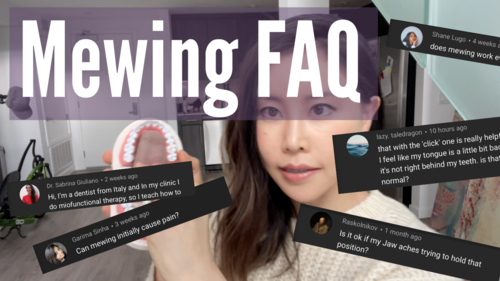There may be some discomfort when the side teeth come into contact with the upper teeth. Is it too late if you're 30 years old? Today, I will be addressing frequently asked questions about mewing. In response to the positive feedback I received from my recent video on mewing, I have gathered some questions and will be answering them for you today.
1. Good Posture
It's never too late for change. At 30 years old, I started learning about and practicing good posture. It took me around five or six years to really incorporate it into my life, starting around the age of 36. Despite not seeing a drastic visual difference, I have personally experienced reduced tension in my face, with the tension shifting from one area to another. Some people might not notice the change, but I feel it. Face yoga has played a significant role in this transformation, along with proper tongue posture. It's worth mentioning that mastering these techniques can be more challenging and time-consuming as you get older. Younger individuals find it easier to learn, maintain, and see quick results. For adults, especially older ones, it may take longer to adapt, and visual changes may be more gradual. However, it's never too late to start. Now, onto the topic of teeth. Ideally, the upper teeth should not touch the lower teeth. They should be slightly apart, with the tongue resting gently on the roof of the mouth.
2. Tongue Posture
Fully touching the upper teeth takes precedence over not touching them or other teeth. Initially, it's acceptable for the tongue to touch other teeth, but the ultimate goal is perfect tongue posture, which may require years of practice. Though my tongue occasionally touches the upper teeth, it's gradually improving. First, establish full contact with the palate and unconsciously maintain it. Then focus on avoiding contact with other teeth. Initially, it's fine for side teeth to touch, but the goal is to avoid touching any other teeth, including the lower ones. Constant teeth contact can lead to tension and TMJ pain, especially in developing teeth. Avoid excessive pressure and clenching, as it can cause problems like overbite. Feeling pressure on front teeth may be due to the tongue touching the maxilla, creating a constant smiling sensation. While cheek tension can be beneficial, excessive pressing should be avoided.
3. Dental Braces or Denture
Is it okay to have dental work like braces or dentures? Yes, it is perfectly fine. There should be a tiny gap between the upper and lower teeth when your face is at rest, regardless of any dental work you have. Avoid teeth contact habits, even with braces. As for tongue posture, it varies from person to person. Some may find the tip of the tongue touching a certain spot, while others may have it slightly farther back. Rolling the tongue slightly is acceptable, though not as ideal as proper tongue posture. If it's comfortable and helps keep your tongue up, you can start with that and gradually transition to the correct posture of lifting the tongue on the palate. Developing the habit of keeping your tongue lifted on the palate is crucial.
4.
Does experiencing jaw pain at the beginning of tongue posture change? Ideally, there should be no pain, but it's normal to feel some discomfort due to the sudden change in muscle behavior. If you don't feel any discomfort initially, it could mean you are naturally doing it correctly or not aware of the correct posture. It's common to lose the correct posture over time due to factors like bad posture or diet. Fixing it can be challenging after years of incorrect posture. Feeling some discomfort is normal, but you should not experience pain. However, if you continue to feel pain, particularly in the jaw area, it may indicate excessive use of the masseter muscle. Correct tongue posture should shift tension from the jaw to the cheek area, reducing jaw pain.
Summary:
In conclusion, adopting good posture and practicing proper tongue posture can have positive effects on facial tension and overall well-being. While it may take time and effort, it's never too late to start incorporating these habits into your daily life. Younger individuals may find it easier to learn and see quick results, but adults can also benefit from these practices, albeit with a potentially longer adjustment period. Maintaining a slight gap between the upper and lower teeth and avoiding teeth contact habits are important, even with dental work like braces or dentures. Finding the right tongue posture that works for you, whether it's slightly back or rolled, can be a personal preference. However, the ultimate goal is to develop the habit of keeping the tongue lifted on the palate. It's normal to experience discomfort during the initial stages, but persistent pain, especially in the jaw area, should be addressed as it may indicate excessive use of the masseter muscle. Correct tongue posture should help alleviate jaw pain by shifting tension to the cheek area. Remember, practicing good posture and proper tongue posture can bring about positive changes, regardless of age.

